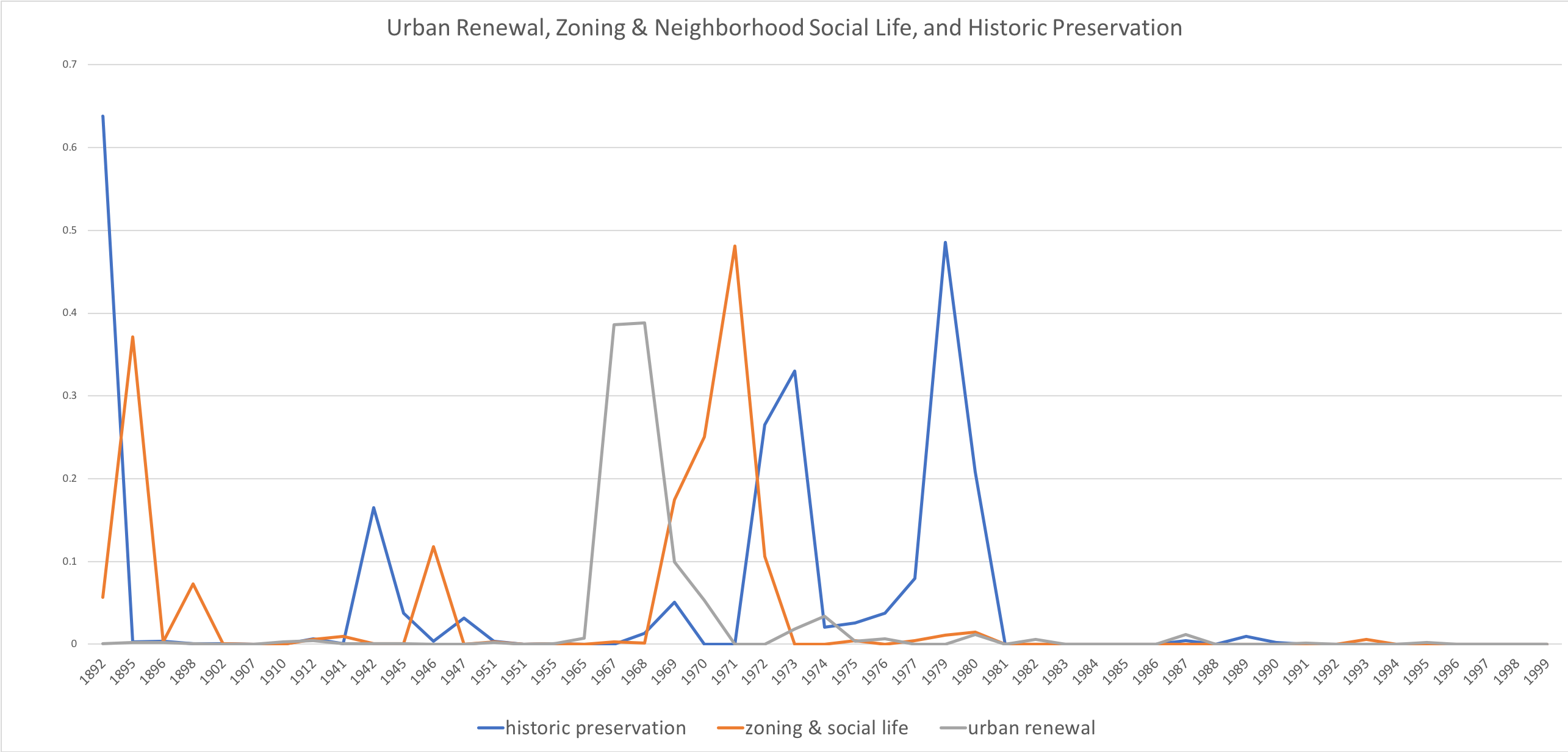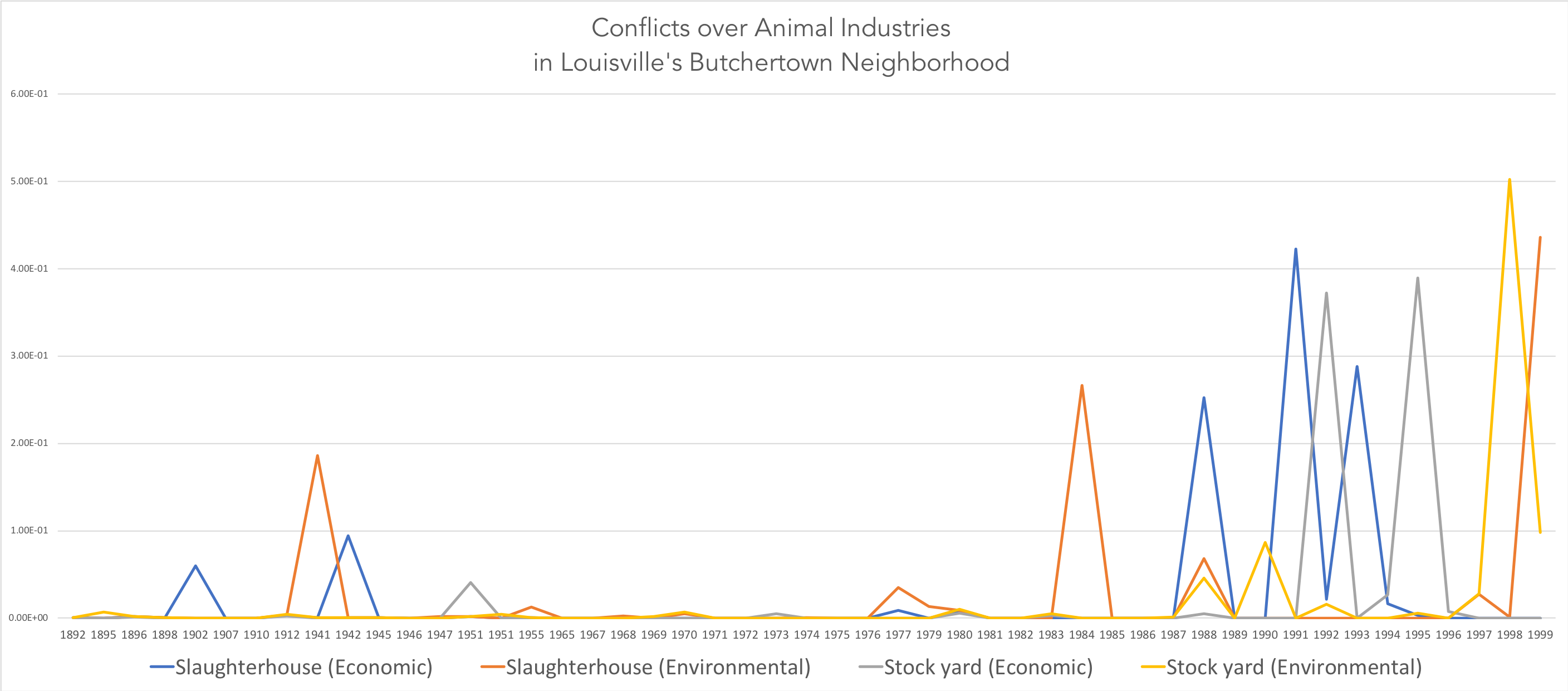Topic Model
Using MALLET, I ran a 20-topic model on a corpus of 380 articles from Louisville's Courier-Journal that were chunked by year, from 1892-1999. I ended the corpus in 1999 because in 1998, the large Bourbon Stock Yard in the Butchertown neighborhood closed, representing a definitive resolution to one half of the ongoing conflict with Butchertown Neighborhood Association (BNA)—the other half being the slaughterhouse that remains in the neighborhood.
Urban Development Discourse

I combined three topics together as an "urban development discourse." As seen in the chart, these topics end around 1981. Although of course discussions of urban development do not end during this time, they are superseded by land use conflicts in the 1980s and 1990s, which can be seen in the second chart, below.
Zoning & neighborhood social life: zoning mrs commission beer german units park annual apartment tour fair big oktoberfest leib days pounds trucks drive social houses
The Zoning & Neighborhood Social Life topic includes words related to the neighborhood's social activities, such as "German," "tour," "social," "fair," and "Oktoberfest." The inclusion of "zoning," "commission," and "trucks" points to a discussion of the neighborhood's industrial zoning. It is the combination of these two discourses that interests me in this topic; that is, does it represent the ways in which neighborhood social life became imbricated in urban development discourse? (While it is possible that this slightly disparate topic is an indicator that I should have included more topics in my model, a 25-topic model did not produce useful information, and so a return to the texts will be necessary to answer my question.)
Historic Preservation: zoning law ordinance houses young historic mrs hadley row pottery james segrest restoration union live louisville’s court adjustment regulations preservation
The Historic Preservation topic once again includes the word "zoning"—a contentious topic within the neighborhood since 1937—but it also has words related to Hadley Pottery, a local pottery manufacturer that took over a former Wool Mill; James Segrest, a Butchertown historic preservation advocate; and the words "restoration," "young," and "preservation." Historic Preservation is a post-industrial urban development tactic that aims to restore the possibility of capital accumulation in the built environment (Harvey, 1985) and hence has a strong place within an urban development discourse.
Urban Renewal: area program poverty houses rehabilitation urban zoning poor restoration settlement cities programs planning williams staff warner renewal carle application projects
The Urban Renewal topic includes plural and generalized words such as "cities," "projects," "poverty," and "programs," pointing towards a discourse consistent with the top-down Urban Renewal program of the 1960s. The topic also includes words related to historic preservation, such as "rehabilitation" and "restoration," indicating a connection between Urban Renewal and historic preservation discourses.

Land Use Conflicts: Animal Industries
The topic model generated four distinct discourses related to animal industries. The 20-acre stock yard and the industrial slaughterhouse are each represented by two discourses: a politico-economic discourse and an environmental discourse. How these two discourses are deployed is an avenue for further investigation.
Slaughterhouse Conflict
The Monfort and Armour companies both owned the slaughterhouse before current owners JBS Swift. The complaints about pollution and the smell are the common threads between these two discourses; the BNA argued the slaughterhouse was a source of air pollution.
Politico-economic: monfort edison smell armour people plant control pollution problem enterprise oertels trucks tichenor group warren jobs return tour ave kahn
In the slaughterhouse's politico-economic discourse, there are references to specific businesses and local organizations--Oertels and Edison, referring to a brewery and Thomas Edison house nonprofit, respectively. The presence of political actors such as Warren, Tichenor and "Kahn"—representatives of the BNA—point to political organizing against the slaughterhouse.
Environmental: monfort plant odors creek association pollution control facade odor-control odor equipment stench waterfront air church armour district problems problem streams
The presence of the words "creek," "streams," "air," and "waterfront" demonstrate a focus on the natural features of the neighborhood as they relate to the slaughterhouse.
Stock Yard Conflict
As mentioned above, the Bourbon Stock Yard closed in 1998; although it closed due to the economics of maintaining a stock yard in an urban downtown, the BNA considered it a victory. Much of the newspaper coverage dealt with the stock yard's 100+ year legacy in the area and what would arise in its place. However, there are still two distinct topics, indicating the conversation and opposition around the stock yard and slaughterhouse followed a similar discursive logic.
Politico-economic: stock market farmers yard stockyard bourbon produce homeless business cattle turnier square-foot producers livestock creation innocents year-old year-round auction love
The focus is on the economics of the stock yard through "livestock," "cattle," and "square-foot." The businesses and nonprofits that would serve as the stockyard's legacy in the neighborhood are represented in "creation," referring to produce distributor Creation Gardens (and "Turnier," the business's owner), and "innocents," which refers to the Home of the Innocents, the nonprofit that was built on the site of the stock yard after it moved. The word "homeless" appears in a few articles about the people who lived on the Bourbon Stock Yard site after it closed and before it was demolished.
Environmental: creek trail home road stockyard beargrass check-in river construction innocents yard hill children village acre stockyards bruker-corwin park children's volunteers
Again the focus in the Environmental discourse is on specific natural features—Beargrass Creek, and "trail," referring to a waterfront trail, as well as Barbie Bruker-Corwin, who was an environmentalist that advocated for creek cleanup.